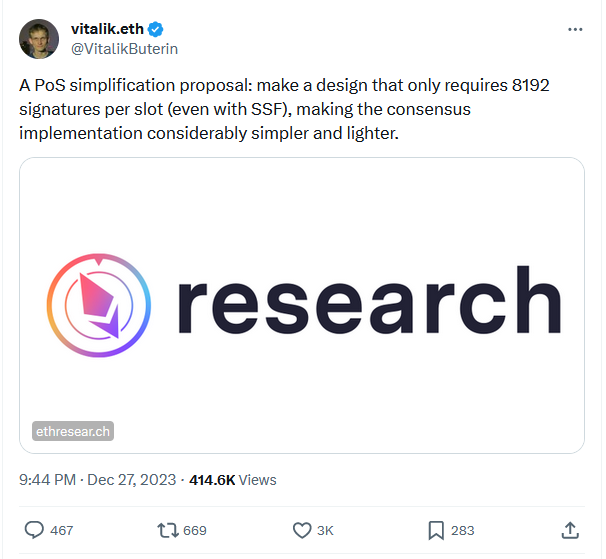- Ethereum Co-Founder Vitalik Buterin proposes a significant simplification of the Proof of Stake (PoS) consensus mechanism.
- The proposal aims to reduce the required signatures per slot to 8,192.
- Ethereum’s current decentralized nature accommodates 895,000 validators.
In a recent proposal, Ethereum Co-Founder Vitalik Buterin has suggested a significant simplification of the Proof of Stake (PoS) consensus mechanism. The proposal aims to streamline the process by reducing the number of required signatures per slot to 8,192, raising questions about the potential centralization of the Ethereum network.
Ethereum currently accommodates an extensive validator network, reaching 895,000 entities. Buterin’s proposal acknowledges the challenges posed by this approach, particularly the high number of signatures required per slot. It currently stands at approximately 28,000 today and is expected to rise to 1,790,000 post-Single Slot Finality (SSF) implementation.
To handle this significant load, the co-founder claimed that Ethereum has to implement a complex attestation propagation mechanism and optimize BLS signature operations. BLS is a signature library focused on performance and security.
Furthermore, the network has to face challenges with quantum-resistant alternatives. Buterin argues that the current approach increases technical complexities, affecting fork choice fixes, signature aggregation, and minimum slot times.
Buterin questions the effectiveness of this strategy, noting that even with the decentralized approach, the minimum requirement to stake remains at 32 ETH, potentially excluding many individuals. He emphasizes the infeasibility of sustaining an “everyone-signs-in-every-slot” system with Ethereum’s potential user base.
In response to these challenges, Buterin proposes a departure from the expectation of an ever-increasing number of signatures per slot. This, he believes, would open up new possibilities, simplify the PoS design, enhance security, and address quantum resistance concerns.
Buterin outlines three potential approaches to achieving the 8,192 signatures per slot goal. These include going all-in on decentralized staking pools, adopting a two-tiered staking system, and implementing rotating participation committees with accountability.
Disclaimer: The information presented in this article is for informational and educational purposes only. The article does not constitute financial advice or advice of any kind. Coin Edition is not responsible for any losses incurred as a result of the utilization of content, products, or services mentioned. Readers are advised to exercise caution before taking any action related to the company.








